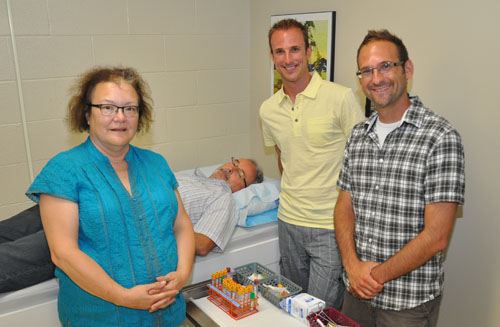
Murray Stevenson is eating a high-fat, high-calorie breakfast in the name of science. As a participant in the Diabetes Research Assessment (DRA) study, he will undergo blood tests and other measurements to determine how his body – and, more importantly, his metabolism – responds to the meal.
“I think that all these studies with respect to diet and health are so important because we’re facing this huge epidemic of diabetes,” says Stevenson, B.Sc.(Agr.) ’76, who works for Health Canada.
Understanding how metabolic differences are linked to an individual’s health is one of the aims of the DRA study, led by Prof. David Mutch, Human Health and Nutritional Sciences. The study is looking at clinically distinct groups of obese and diabetic people, including those who are considered “metabolically healthy obese.”
People who have a body mass index (BMI) greater than 30 are considered obese, but that doesn’t mean they have a similar risk for developing associated diseases. Recent estimates show that 30 per cent of people with a BMI greater than 30 “don’t have the metabolic risk factors that would predispose them to diabetes, cardiovascular disease and hypertension,” says Mutch. “So while these subjects may have excess body weight, they are considered metabolically healthy.”
Is it possible to have a healthy metabolism and be obese? Mutch says the relatively new concept is becoming more widely accepted in the medical community, although little research has been done on metabolically healthy obese people. “If you actually encouraged them to lose weight, they might be going out of their metabolically optimal situation and this could inadvertently increase their risk for other health complications.”
The DRA study wouldn’t be possible without the participation of Dr. Susan Stephenson and her colleagues in the Guelph Family Health Team. “I’m very excited about this project,” says Mutch. “It’s really interactive with the Guelph community.” Participants usually spend about four hours on campus to complete the study. He aims to recruit 80 participants, half with diabetes managed without medication.
The researchers are collecting several physiological measurements, including body fat composition. Although BMI based on an individual’s weight-to-height ratio is one of the easiest ways to determine whether someone is at a healthy weight, Mutch says the measure fails to account for the fat-to-muscle ratio. An athlete with a BMI of 30, for example, could be considered obese, even if the excess weight is mostly muscle, not fat. At the other end of the scale, people considered lean by BMI standards may have a high body fat percentage.
The location of body fat can also affect health risk. People who carry extra weight around their mid-section (apple-shaped bodies) face more risk of cardiovascular disease than those who carry weight around their hips and thighs (pear-shaped bodies).
Mutch is also looking at gene expression profiles to find out how fat tissue behaves in different participants. Stephenson is collecting fat tissue samples from study participants and will use gene expression profiling technologies to show which genes differ between obese and diabetic subjects.
Nutrigenomics, which looks at the interaction between nutrition and genes, will also be under the microscope. After eating the same high-fat, high-calorie breakfast, all study participants will undergo blood tests to measure their glucose and insulin response.
“We’re trying to see how these different groups of people are responding to this meal,” says Mutch. “I believe there’s an underlying genetic or molecular network that will actually determine why people are responding to the same meal in different ways. One of the goals of the DRA study is to identify these determinants.”
Learning why people respond in a certain way to a particular meal could help researchers better predict a person’s response and provide dietary advice tailored to their genetic or molecular makeup, with the ultimate goal of improving compliance. “We can use this information to guide what the best diet would be for somebody to achieve whatever their goal is, whether it’s losing weight or maintaining weight loss or improving insulin sensitivity.”
The researchers are recruiting 80 participants between the ages of 35 and 70 for the following groups: lean healthy people; lean individuals with Type 2 diabetes; and individuals with a BMI greater than 30 with or without Type 2 diabetes. “Seventy per cent of people who are obese are also Type 2 diabetics,” says Mutch.

Assisting Mutch is PhD student Mike Zulyniak, who was drawn to the study because of its focus on diet and health. “My background is in exercise physiology, and I wanted to take that and apply it to human health and nutrition.” He’s most interested in identifying the differences between lean and obese participants from clinical, metabolic and genetic perspectives. His grandfather’s struggle with Type 2 diabetes also inspired him to study the disease. “Any way that I can help with Type 2 diabetes just makes me feel really good.”
Also working with Mutch is master’s student Maude Perreault, who did her undergrad in nutrition at the Université de Montréal. “I’m really interested in the metabolically healthy obese,” she says. “I really want to understand why some people have diabetes and some people don’t, but it’s not always related to excess weight.”
To learn more about the DRA study, email drastudy@uoguelph.ca.
This study is funded by the Public Health Agency of Canada.